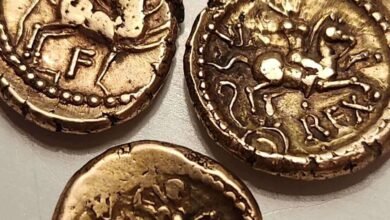Roman toilet spoon and Bronze Age treasure among the treasure finds

A museum in Wales, UK, has discovered a hoard of ancient Bronze Age treasures
The discoveries detailed by Amgueddfa Cymru – Museum Wales in a new report include Bronze Age sword fragments, a Roman toilet spoon and a silver ring.
The Bronze Age treasure was found in 2019 by metal detectorist Mark Herman in the Vale of Glamorgan in southeast Wales. The artifacts have now been examined by curators who have determined their significance.
The treasure includes fragments of two bronze swords and five bronze axes from around 1000 to 800 BC. BC, i.e. the Late Bronze Age. These finds support archaeologists’ belief that there was a metal exchange during this period that spanned Wales, England and northern France, as many Late Bronze Age metals have been found in these regions.
Amgueddfa Cymru – Museum Wales.
“This hoard is unusual in that it contains fragments of two swords, one of which is a blade tip fragment with decorative grooves, made in north-west France,” says Chris Griffiths, a PhD student at Amgueddfa Cymru – Museum Wales and the University of Reading. said in a summary of the new treasures.
“This small sword fragment is therefore an important part of a much larger story that connects the people who lived in Pendoylan [village] Community with those who lived in northwestern France about 3,000 years ago.
The museum also declared a Roman ligule, also known as a “toilet spoon.” This was discovered by Valentinas Avdejevas while metal detecting in the Vale of Glamorgan in 2020. In ancient times, toilet spoons were a tool used primarily for cosmetics or for dispensing medicines. It is not entirely clear whether one use was preferred over the other.
Although it may seem like a small find, discoveries like this point to how the ancient Romans practiced hygiene and medicine.
Carlton Sheath also discovered a post-medieval silver finger ring in Powys, Wales. The ring is decorated with beads in a zigzag pattern. Archaeologists also noticed some traces of a previous owner.
It is not dissimilar to other finds from the early 16th century, a report says, meaning it provides a clearer picture of trends at the time.

“This decorative silver-gilt finger ring is a fine example of a type popular in the 15th and 16th centuries,” Sian Iles, curator of medieval and later archeology at Amgueddfa Cymru – National Museum Wales, said in the summary of the finds.
“Thanks to the Portable Antiquities Scheme and the provisions of the Treasure Act, as well as timely reporting by the finder, objects such as this are being recorded, contributing significantly to our growing understanding of fashion and style in late medieval and early Tudor Wales.”
New finds from antiquity are constantly being discovered. Every new find, no matter how small, is a piece of the puzzle to learn more about the lives of these ancient people. These finds will be houses in the museum.
Do you have a tip for a science story? Newsweek should cover? Do you have a question about the Bronze Age? Let us know at science@newsweek.com.
Unusual knowledge
Newsweek strives to challenge conventional wisdom and find connections in the search for common ground.
Newsweek strives to challenge conventional wisdom and find connections in the search for common ground.



